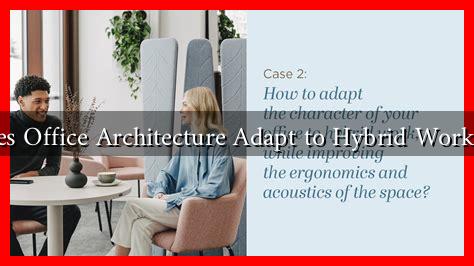-
Table of Contents
How Does Office Architecture Adapt to Hybrid Work Models?
The rise of hybrid work models has transformed the landscape of office architecture. As organizations embrace flexible work arrangements, the design and functionality of office spaces must evolve to meet the needs of a diverse workforce. This article explores how office architecture is adapting to hybrid work models, highlighting key trends, innovative designs, and the implications for employee productivity and well-being.
The Shift to Hybrid Work Models
Hybrid work models combine remote and in-office work, allowing employees to choose where they work based on their tasks and preferences. According to a survey by McKinsey, 58% of employees prefer a hybrid work model, indicating a significant shift in workplace expectations. This change necessitates a reevaluation of office design to create environments that foster collaboration, creativity, and comfort.
Key Architectural Adaptations
As organizations transition to hybrid work models, several architectural adaptations are becoming increasingly common:
- Flexible Workspaces: Traditional cubicles are being replaced with open layouts that include hot-desking, collaborative zones, and quiet areas. This flexibility allows employees to choose spaces that suit their work style.
- Technology Integration: Smart office technology is essential for hybrid work. Features like video conferencing tools, wireless charging stations, and app-controlled environments enhance connectivity and productivity.
- Health and Wellness Focus: Post-pandemic, there is a heightened emphasis on health. Offices are incorporating better ventilation, natural light, and biophilic design elements to improve employee well-being.
- Multi-Functional Spaces: Areas that can serve multiple purposes—such as meeting rooms that can be reconfigured for different group sizes—are becoming standard. This adaptability supports various work activities.
Case Studies: Successful Implementations
Several companies have successfully adapted their office architecture to support hybrid work models:
- Salesforce: The Salesforce Tower in San Francisco features open spaces, collaborative areas, and wellness rooms. The design encourages teamwork while providing quiet spaces for focused work.
- Google: Google’s offices are known for their innovative designs that prioritize employee comfort and collaboration. Their hybrid model includes flexible workspaces and outdoor areas that promote creativity.
- WeWork: As a pioneer in flexible office spaces, WeWork has adapted its offerings to include hybrid solutions that cater to both remote and in-office workers, providing a variety of workspace options.
Statistics Supporting the Shift
Data underscores the importance of adapting office architecture to hybrid work models:
- According to a report by Gartner, 82% of company leaders plan to allow employees to work remotely at least part of the time.
- A study by Harvard Business Review found that companies with flexible work arrangements saw a 20% increase in employee productivity.
- Research from the Global Workplace Analytics indicates that 30% of the workforce could work remotely by the end of 2023, emphasizing the need for adaptable office designs.
Challenges and Considerations
While the shift to hybrid work presents opportunities, it also poses challenges for office architecture:
- Space Utilization: Organizations must carefully assess how to utilize their office space effectively, balancing the need for collaborative areas with individual workspaces.
- Employee Engagement: Maintaining a sense of community and culture in a hybrid environment can be difficult, necessitating thoughtful design that encourages interaction.
- Cost Implications: Renovating existing spaces or building new ones to accommodate hybrid work can be costly, requiring strategic planning and investment.
Conclusion
The adaptation of office architecture to hybrid work models is not just a trend; it is a necessity for modern organizations. By embracing flexible designs, integrating technology, and prioritizing employee well-being, companies can create environments that enhance productivity and satisfaction. As the workforce continues to evolve, so too must the spaces in which we work. The future of office architecture lies in its ability to adapt, innovate, and respond to the changing needs of employees.
For more insights on workplace design and hybrid work models, visit Gartner.

